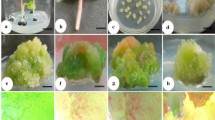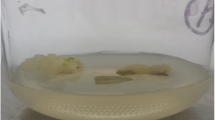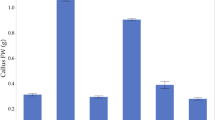Abstract
The antioxidative phytochemicals in globe artichoke (Cynara scolymus L.) have received increasing attention for their health-promoting properties related to the high levels of caffeoylquinic acids and flavones in capitula and leaves. Since phytochemicals in plants vary in relation to both biotic and abiotic factors, we explored the possibility to use in vitro-derived materials as a source of antioxidant compounds. Two suspension cultures, an anthocyanin-producing and not-producing cultures, and the sourced callus were evaluated in terms of their total polyphenol (TP) content and qualitative profile, total anthocyanin (TA) content and antioxidant activity (AA). TP and TA content were quantified by spectrophotometric assays, while the polyphenol profile was estimated by HPLC analysis. AA was evaluated by 2,2-diphenyl-1-picrylhydrazyl (DPPH) and ferric reducing antioxidant power (FRAP) assays. Growth kinetics and polyphenol accumulation were investigated for 25 days in red suspension cultures. The latter accumulated a higher TP and TA content (25.7 and 2.61 g kg−1 of DM, respectively) than calluses and green suspension cultures. During cell growth, the TA content in red suspension cultures ranged from 1.43 to 2.41 g kg−1 of DM. Optimum production of polyphenols was achieved on day 25 of culture; a positive correlation existed between TP and both DPPH (r = 0.84) and FRAP (r = 0.85). The 1,5–O-dicaffeoylquinic acid and cyanidin malonylglucoside (21.18 and 1.24 g kg−1 of DM, respectively) were the primary compounds. The results of this investigation indicate that cell suspension of globe artichoke could represent a potential source of bioactive compounds with high antioxidant properties for industrial applications.

Similar content being viewed by others
Abbreviations
- NAA:
-
α-Naphthalene acetic acid
- BAP:
-
6-Benzylaminopurine
- MS:
-
Murashige and Skoog (1962) medium
- B5:
-
Gamborg et al. (1968) medium
- FW:
-
Fresh weight
- DM:
-
Dry matter
- CVS:
-
Cell volume after sedimentation
- HPLC:
-
High-performance liquid chromatography
- FRAP:
-
Ferric reducing-antioxidant power
- DPPH:
-
2,2-Diphenyl-1-picrylhydrazyl
- TP:
-
Total polyphenol
- TA:
-
Total anthocyanin
- AA:
-
Antioxidant activity
References
Ali M, Abbasi BH, Ulhaq I (2013) Production of commercially important secondary metabolites and antioxidant activity in cell suspension cultures of Artemisia absinthium L. Ind Crop Prod 49:400–406
Balasundram N, Sundram K, Samman S (2006) Phenolic compounds in plants and agri-industrial by-products: antioxidant activity, occurrence, and potential uses. Food Chem 99:191–203
Beckman CH (2000) Phenolic-storing cells: keys to programmed cell death and periderm formation in wilt disease resistance and in general defence responses in plants? Physiol Mol Plant Pathol 57:101–110
Bhattacharyya P, Kumaria S, Job N, Tandon P (2015) Phyto-molecular profiling and assessment of antioxidant activity within micropropagated plants of Dendrobium thyrsiflorum: a threatened, medicinal orchid. Plant Cell Tissue Org 122:535–550
Brand-Williams W, Cuvelier ME, Berset C (1995) Use of a free radical method to evaluate antioxidant activity. Lebensm-Wiss Technol 22:25–30
Ciancolini A, Alignan M, Pagnotta MA, Miquel J, Vilarem G, Crinò P (2013) Morphological characterization, biomass and pharmaceutical compounds in Italian globe artichoke genotypes. Ind Crop Prod 49:326–333
Cicco N, Lanorte MT, Paraggio M, Viggiano M, Lattanzio V (2009) A reproducible, rapid and inexpensive Folin–Ciocalteu micro-method in determining phenolics of plant methanol extracts. Microchem J 91:107–110
Davies KM, Delores SC (2014) Prospects for the use of plant cell cultures in food biotechnology. Curr Opin Biotechnol 26:133–140
Deroles S (2009) Anthocyanin biosynthesis in plant cell cultures: a potential source of natural colourants. In: Gould K, Davies KM, Winefield C (eds) Anthocyanins: biosynthesis, functions and applications. Springer, New York, pp 108–167
Diwan R, Shinde A, Malpathak N (2012) Phytochemical composition and antioxidant potential of Ruta graveolens L. in vitro culture lines. J Bot. doi:10.1155/2012/685427
Dong X, Wang Y, Liu T, Wu P, Gao J, Xu J, Yang B, Hu Y (2011) Flavonoids as vasorelaxant agents: synthesis, biological evaluation and quantitative structure activities relationship (QSAR) studies. Molecules 16:8257–8272
Embuscado ME (2015) Spices and herbs: natural sources of antioxidants - a mini review. J Funct Food 18(Part B):811–819
Firuzi O, Lacanna A, Petrucci R, Marrosu G, Saso L (2005) Evaluation of the antioxidant activity of flavonoids by “ferric reducing antioxidant power” assay and cyclic voltammetry. Biochim Biophys Acta 1721:174–184
Giri L, Dhyani P, Rawat S, Bhatt ID, Nandi SK, Rawal RS, Pande V (2012) In vitro production of phenolic compounds and antioxidant activity in callus suspension cultures of Habenaria edgeworthii: a rare Himalayan medicinal orchid. Ind Crop Prod 39:1–6
Holst B, Williamson G (2008) Nutrients and phytochemicals: from bioavailability to bioefficacy beyond antioxidants. Curr Opin Biotechnol 19:73–82
Huang D, Ou B, Prior RL (2005) The chemistry behind antioxidant capacity assays. J Agric Food Chem 53:1841–1856
Jeong BR, Sivanesan I (2015) Direct adventitious shoot regeneration, in vitro flowering, fruiting, secondary metabolite content and antioxidant activity of Scrophularia takesimensis Nakai. Plant Cell Tissue Org 123:607–618
Kukić J, Popović V, Petrović S, Mucaji P, Ćirić A, Stojković D, Soković M (2008) Antioxidant and antimicrobial activity of Cynara cardunculus extracts. Food Chem 107:861–868
Lewandowska U, Szewczyk K, Hrabec E, Janecka A, Gorlach S (2013) Overview of metabolism and bioavailability enhancement of polyphenols. J Agric Food Chem 61:12183–12199
Lo Scalzo R, Genna A, Branca F, Chedin M, Chassaigne H (2008) Anthocyanin composition of cauliflower (Brassica oleracea L. var. botrytis) and cabbage (B. oleracea L. var. capitata) and its stability in relation to thermal treatments. Food Chem 107:136–144
Menin B, Moglia A, Comino C, Hakkert JC, Lanteri S, Beekwilder J (2013) In vitro callus-induction in globe artichoke (Cynara cardunculus L. var. scolymus). J Hortic Sci Biotechnol 88:537–542
Mulabagal V, Tsay H (2004) Plant cell cultures - an alternative and efficient source for the production of biologically important secondary metabolites. Int J Appl Sci Eng 1:29–48
Murashige T, Skoog F (1962) A revised medium for rapid growth and bioassays with tobacco tissue cultures. Physiol Plant 15:473–497
Natali RM, de Winter W, van Iren F, Verpoorte R (2011) Initiation, growth and cryopreservation of plant cell suspension cultures. Nat Protoc 6:715–742
Ordas RJ, Tavazza R, Ancora G (1991) Callus formation from isolated globe artichoke (Cynara scolymus L.) suspension protoplast. Plant Sci 77:253–259
Pandino G, Lombardo S, Mauro RP, Mauromicale G (2012a) Variation in polyphenol profile and head morphology among clones of globe artichoke selected from a landrace. Sci Hortic Amst 138:259–265
Pandino G, Lombardo S, Mauromicale G, Williamson G (2012b) Characterization of phenolic acids and flavonoids in leaves, stems, bracts and edible parts of globe artichokes. Acta Hortic 942:413–417
Pandino G, Lombardo S, Williamson G, Mauromicale G (2012c) Polyphenol profile and content in wild and cultivated Cynara cardunculus L. Ital J Agric 7:254–261
Pandino G, Lombardo S, Lo Monaco A, Mauromicale G (2013a) Choice of time of harvest influences the polyphenol profile of globe artichoke. J Funct Foods 5:1822–1828
Pandino G, Lombardo S, Mauromicale G (2013b) Globe artichoke leaves and floral stems as a source of bioactive compounds. Ind Crop Prod 44:44–49
Pandino G, Lombardo S, Moglia A, Portis E, Lanteri S, Mauromicale G (2015) Leaf polyphenol profile and SSR-based finger printing of new segregant Cynara cardunculus genotypes. Front Plant Sci. doi:10.3389/fpls.2014.00800
Santana-Méridas O, González-Coloma A, Sánchez-Vioque R (2012) Agricultural residues as a source of bioactive natural products. Phytochem Rev 11:447–466
Saw NMMT, Riedel H, Cai Z, Kütük O, Smetanska I (2012) Stimulation of anthocyanin synthesis in grape (Vitis vinifera) cell cultures by pulsed electric fields and ethephon. Plant Cell Tissue Org 108:47–54
Schütz K, Persike M, Carle R, Schieber A (2006) Characterization and quantification of anthocyanins in selected artichoke (Cynara scolymus L.) cultivars by HPLC-DAD-ESI-MSn. Anal Bioanal Chem 384:1511–1517
Shahidi F (1997) Natural antioxidants: an overview. In: Shahidi F (ed) Natural antioxidants: chemistry, health effects, and applications. AOCS Press, Champaign, pp 1–7
Szopa A, Ekiert H (2012) In vitro cultures of Schisandra chinensis (Turcz.) Baill. (Chinese Mangolia vine)—a potential biotechnological rich source of therapeutically important phenolic acids. Appl Biochem Biotechnol 166:1941–1948
Trajtemberg SP, Apostolo NM, Fernadez G (2006) Calluses of Cynara cardunculus var. cardunculus cardoon (Asteraceae): determination of cynarine and chlorogenic acid by automated high-performance capillary electrophoresis. In Vitro Cell Dev 42:534–537
Truong V, Deighton N, Thompson RT, Mcfeeters RF, Dean L, Pecota KV, Yencho GC (2010) Characterization of anthocyanins and anthocyanidins in purple-fleshed sweetpotatoes by HPLC-DAD/ESI-MS/MS. J Agric Food Chem 58:404–410
Wang L, Stoner GD (2008) Anthocyanins and their role in cancer prevention. Cancer Lett 269:281–290
Wang M, Simon JE, Aviles IF, He K, Zheng QY, Tadmor Y (2003) Analysis of antioxidative phenolic compounds in artichoke (Cynara scolymus L.) J Agric Food Chem 51:601–608
Wong CC, Meinl W, Glatt H, Barron D, Stalmach A, Steiling H, Crozier A, Williamson G (2010) In vitro and in vivo conjugation of dietary hydroxycinnamic acids by UDP-glucuronosyltransferases and sulfotransferases in humans. J Nutr Biochem 11:1060–1068
Zhang W, Furusaki S (1997) Regulation of anthocyanin synthesis in suspension cultures of strawberry cell by pH. Biotechnol Lett 19:1057–1061
Żur I, Dubas E, Krzewska M, Janowiak F, Hura K, Pociecha E, Bączek-Kwinta R, Płażek A (2014) Antioxidant activity and ROS tolerance in triticale (× Triticosecale Wittm.) anthers affect the efficiency of microspore embryogenesis. Plant Cell Tissue Org 119:79–94
Author information
Authors and Affiliations
Corresponding author
Rights and permissions
About this article
Cite this article
Pandino, G., Meneghini, M., Tavazza, R. et al. Phytochemicals accumulation and antioxidant activity in callus and suspension cultures of Cynara scolymus L.. Plant Cell Tiss Organ Cult 128, 223–230 (2017). https://doi.org/10.1007/s11240-016-1102-6
Received:
Accepted:
Published:
Issue Date:
DOI: https://doi.org/10.1007/s11240-016-1102-6




